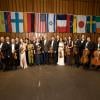
Founded in 2015, the orchestral ensemble known as Kontrapunktus (the German spelling of the Latin for “counterpoint”) performs at a variety of venues throughout Los Angeles with the mission of showcasing highly skilled post-conservatory instrumentalists, focusing in particular on music of the Baroque period.
The group’s current concert program pays homage to the Collegium Musicum of Leipzig circa the early 18th century and its two most notable directors: Georg Philipp Telemann and Johann Sebastian Bach. The collegium emerged as a place for social gathering (in several different locations but eventually, by the time of Bach’s directorship in 1729, the coffeehouse of Gottfried Zimmermann). Young musicians could display their talent while composers could experiment outside the restrictive edicts of their church employers.
Ironically, given that history, Kontrapunktus’s performance on Saturday, Aug. 17, took place within the sanctuary of the Seventh-day Adventist Church in Culver City. The group reprises the program Aug. 23–25 at several other Los Angeles-area venues.
The showcase nature of the collegium was in full flower at this concert, which featured an ensemble of exceedingly skilled young musicians: concertmaster Cameron Alan-Lee; artistic director and cellist Osheen Manukyan; violinists Leonard Fu, David Chang, and Haesol Lee; violist Cassia Drake; bassist Ethan Moffitt; and harpsichordist Keika Mori.
Weaving its way through dance suites, sonatas, and concertos, the program climaxed with a performance of J.S. Bach’s Violin Concerto No. 2 in E Major, BWV 1042, with the elegant Aubree Oliverson as soloist. Performing on a 1735 violin crafted by Giovanni Battista Guadagnini (loaned by Irene R. Miller through Beare’s International Violin Society) and a Jean “Grand” Adam bow (on loan from the Metzler Violin Shop), Oliverson offered a rendition that filled the hall with a bouquet of tonal lushness and flashes of virtuoso fireworks.

Though the program was loosely chronological, it gathered momentum, compositional fluidity, and complexity as it built toward its finale.
After spending a good deal of time tuning to the harpsichord, the ensemble embarked on Telemann’s Ouverture-Suite in G Major, TWV 55:G2 (“La Bizarre”). It’s a candy sampler of eight alternating dances — a swinging gavotte, a courante, a pair of dainty minuets, and so on.
The four movements of Bach’s Violin Sonata in E Minor, BWV 1023, gave concertmaster Alan-Lee a chance to demonstrate his agility and expressivity. After this, I moved to the back of the hall, where there was a much more homogeneous blending of the tone. This certainly allowed the three movements and instrumental interplay of Telemann’s Concerto for Three Violins in F Major, TWV 53:F1, to shine as Alan-Lee, Chang, and Fu had a wonderful time volleying melodies among themselves.
If there is an example of Bach’s music that is more rhapsodic than the Orchestral Suite No. 3 in D Major, BWV 1068, I’m not sure what it is. The piece’s second movement, the often-heard Air, achieved in this performance exactly the aura of ethereal serenity needed.
Following the back-and-forth interplay of Telemann’s Quartet in A Minor, TWV 43:A5, it was time for Oliverson to make her entrance in a floor-length sapphire-blue gown. But her instrument was more impressive. It is one of those rare violins that instantly demands your attention with its combination of honey-rich tone and volume. We were clearly in the presence of a virtuoso musician and a virtuoso instrument. This performance brought back memories of hearing Pinchas Zukerman put a bow to the strings of a Guarneri “del Gesù.”
Poised and confident, Oliverson let Bach’s precision and the work’s homage to the music of Antonio Vivaldi and Arcangelo Corelli shine. The solo voice of her violin alternated between aria-like airiness and a smoothly textured blending with the ensemble.
As an encore, she performed a string arrangement of “Sheep May Safely Graze,” the aria from Bach’s “Hunting” Cantata.
What more could you ask for?




